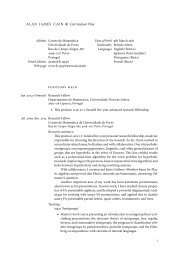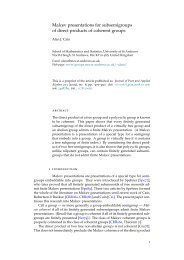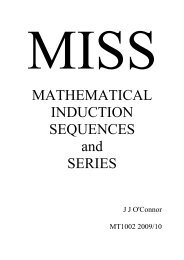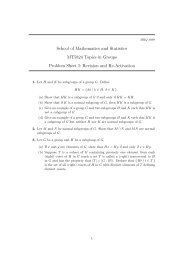Primitive groups and maximal subgroups
Primitive groups and maximal subgroups
Primitive groups and maximal subgroups
You also want an ePaper? Increase the reach of your titles
YUMPU automatically turns print PDFs into web optimized ePapers that Google loves.
Permutation <strong>groups</strong>Classifications of <strong>Primitive</strong> GroupsMaximal sub<strong>groups</strong> of almost simple <strong>groups</strong><strong>Primitive</strong> <strong>groups</strong> <strong>and</strong> <strong>maximal</strong> sub<strong>groups</strong>Dartmouth ColloquiumColva Roney-Dougal3 December 2009Colva Roney-Dougal<strong>Primitive</strong> <strong>groups</strong> <strong>and</strong> <strong>maximal</strong> sub<strong>groups</strong>
Permutation <strong>groups</strong>Classifications of <strong>Primitive</strong> GroupsMaximal sub<strong>groups</strong> of almost simple <strong>groups</strong>Main Goal of Finite Group Theory?Classify all finite <strong>groups</strong>Determine list L containing all finite <strong>groups</strong>, <strong>and</strong> for eachisomorphism class of <strong>groups</strong> describe all ways it occurs in L.. . . by order?Small Groups Library [Besche, Eick & O’Brien]: complete for|G| ≤ 2000, if |G| ≠ 1024, plus various “nicely factorising” orders.. . . by structure?Classification of Finite Simple Groups describes all finite simple<strong>groups</strong> – but we don’t know all ways of putting simples together.. . . by permutation or matrix representation?Given G, determine all embeddings of G in S n or GL d (q); given S nor GL d (q), describe all sub<strong>groups</strong>.Colva Roney-Dougal<strong>Primitive</strong> <strong>groups</strong> <strong>and</strong> <strong>maximal</strong> sub<strong>groups</strong>
Permutation <strong>groups</strong>Classifications of <strong>Primitive</strong> GroupsMaximal sub<strong>groups</strong> of almost simple <strong>groups</strong>Mostly DefinitionsIntransitive <strong>and</strong> imprimitive <strong>groups</strong>Structure of primitive <strong>groups</strong>The degree of G ≤ S n is n (with n < ∞); write n = {1, . . . , n}.If for all α, β ∈ n there exists g ∈ G with αg = β then G istransitive. Otherwise G is intransitive.G = 〈(1, 2, 3, 4), (2, 4)〉 ≤ S 4H = 〈(1, 2, 3, 4)(5, 6), (2, 4)〉 ≤ S 6transitiveintransitiveA point stabiliser of G ≤ S n isG α = {g ∈ G : αg = α},for α ∈ n. All point stabilisers are sub<strong>groups</strong> of G.G 1 = 〈(2, 4)〉 = H 1 .Colva Roney-Dougal<strong>Primitive</strong> <strong>groups</strong> <strong>and</strong> <strong>maximal</strong> sub<strong>groups</strong>
Permutation <strong>groups</strong>Classifications of <strong>Primitive</strong> GroupsMaximal sub<strong>groups</strong> of almost simple <strong>groups</strong>Let’s classify all permutation <strong>groups</strong>!Intransitive <strong>and</strong> imprimitive <strong>groups</strong>Structure of primitive <strong>groups</strong>n 2 3 4 5 6 7 8 9 10 11 12#G 2 4 11 19 56 96 296 554 1593 3094 10723Theorem (Pyber ’93)The number of permutation <strong>groups</strong> of degree n is bounded belowby 2 (1/16+o(1))n2 .Pyber conjectures: This bound is sharpLemmaAn intransitive group is a subdirect product of transitive <strong>groups</strong>.(subdirect product: subgp of direct prod that projects onto each factor). . . so we restrict ourselves to transitive <strong>groups</strong>.Colva Roney-Dougal<strong>Primitive</strong> <strong>groups</strong> <strong>and</strong> <strong>maximal</strong> sub<strong>groups</strong>
Permutation <strong>groups</strong>Classifications of <strong>Primitive</strong> GroupsMaximal sub<strong>groups</strong> of almost simple <strong>groups</strong>Classifications of transitive <strong>groups</strong>Intransitive <strong>and</strong> imprimitive <strong>groups</strong>Structure of primitive <strong>groups</strong>1858 prize question of the Académie des Sciences:Quels peuvent être les nombres de valeurs des fonctions biensdéfinies qui contiennent un nombre donné de lettres, et commentpeut-on former les fonctions pour lesquelles il existe un nombredonné de valeurs?That is: What are the indices of all sub<strong>groups</strong> of S n ?Three submissions in 1860, no prize awarded!Classifications of transitive <strong>groups</strong> of low degree:Problems:n ≤ 30, Hulpke 2005 n ≤ 32, Holt 2008.Number of <strong>groups</strong> grows very fast: n = 32 gives 2, 801, 324.Of these, 98% have order 2 i for some i – not much variety.Colva Roney-Dougal<strong>Primitive</strong> <strong>groups</strong> <strong>and</strong> <strong>maximal</strong> sub<strong>groups</strong>
Permutation <strong>groups</strong>Classifications of <strong>Primitive</strong> GroupsMaximal sub<strong>groups</strong> of almost simple <strong>groups</strong>Some remarks on point stabilisersIntransitive <strong>and</strong> imprimitive <strong>groups</strong>Structure of primitive <strong>groups</strong>LemmaLet G ≤ S n be transitive.The degree, n, of G is equal to |G|/|G α |, for any α ∈ n.For all α, β ∈ Ω, G α <strong>and</strong> G β are conjugate sub<strong>groups</strong> of G.G is primitive if <strong>and</strong> only if G α is a <strong>maximal</strong> subgroup of G.(conjugate: there is a g ∈ G such that g −1 G α g = G β )(H ≤ G is <strong>maximal</strong> if the only proper subgroup of G containing H is H)G transitive ⇒ can identify elements of n with cosets of G 1 in G:1 ↔ G 1 , 2 ↔ G 1 g 2 = {gg 2 : g ∈ G 1 }, 3 ↔ G 1 g 3 , . . .where 1g i = i.. . . so studying permutation reps ↔ studying sub<strong>groups</strong>.Colva Roney-Dougal<strong>Primitive</strong> <strong>groups</strong> <strong>and</strong> <strong>maximal</strong> sub<strong>groups</strong>
Permutation <strong>groups</strong>Classifications of <strong>Primitive</strong> GroupsMaximal sub<strong>groups</strong> of almost simple <strong>groups</strong>Permutation Group ReductionsIntransitive <strong>and</strong> imprimitive <strong>groups</strong>Structure of primitive <strong>groups</strong>TheoremLet G be imprimitive, ∆ a block, Γ = {∆g : g ∈ G}.Let G {∆} be the setwise stabiliser of ∆.Let G Γ be the permutation group induced by G on Γ.Then G is a subgroup of G {∆} ≀ G Γ .Consider C 6 = 〈(1, 2, 3, 4, 5, 6)〉1 Has blocks {{1, 4}, {2, 5}, {3, 6}}, so C 6 ≤ C 2 ≀ C 3 .2 Has blocks {{1, 3, 5}, {2, 4, 6}}, so C 6 ≤ C 3 ≀ C 2 .Implication: <strong>Primitive</strong> <strong>groups</strong> are the building blocks of allpermutation <strong>groups</strong>.What are the primitive <strong>groups</strong> of degree n?Colva Roney-Dougal<strong>Primitive</strong> <strong>groups</strong> <strong>and</strong> <strong>maximal</strong> sub<strong>groups</strong>
Permutation <strong>groups</strong>Classifications of <strong>Primitive</strong> GroupsMaximal sub<strong>groups</strong> of almost simple <strong>groups</strong>HistoryClassification methodsWhat are the primitive <strong>groups</strong> of degree n?1871. Jordan, n ≤ 17.Some omissions in degrees 9, 12, 15, 16, 17.1874. Jordan, n = 19.Stated that are alternating, symmetric or of affine type.1893. Cole, n = 9 corrected.1895–1900. Miller, n = 12, . . . , 17 corrected.By 1912. n ≤ 20.Hiatus1960s. Start of ‘practical’ computational algebra.1970. Sims, rechecked n ≤ 20. Computational.By 1970. Sims, n ≤ 50. Turned into databases in Cayley,GAP <strong>and</strong> Magma.Colva Roney-Dougal<strong>Primitive</strong> <strong>groups</strong> <strong>and</strong> <strong>maximal</strong> sub<strong>groups</strong>
Permutation <strong>groups</strong>Classifications of <strong>Primitive</strong> GroupsMaximal sub<strong>groups</strong> of almost simple <strong>groups</strong>The Classification <strong>and</strong> BeyondHistoryClassification methods1980s: Classification of Finite Simple Groups; the O’Nan–ScottTheorem.Problem now splits into two main parts:1 Classify the <strong>maximal</strong> sub<strong>groups</strong> of the almost simple <strong>groups</strong> ofindex n (insoluble socles).2 Classify the irreducible sub<strong>groups</strong> of GL d (p), where p d = n(soluble socles).1988. Dixon & Mortimer. Insoluble socles for n < 1000.1991. Short. <strong>Primitive</strong> soluble <strong>groups</strong> for n < 256.2003. Eick & Höfling. <strong>Primitive</strong> soluble <strong>groups</strong> for n < 6561.2003. Roney-Dougal & Unger. Soluble socles for n < 1000.2005. Roney-Dougal. All for n < 2500.2009. Coutts, Quick & Roney-Dougal. All for n < 4096.Colva Roney-Dougal<strong>Primitive</strong> <strong>groups</strong> <strong>and</strong> <strong>maximal</strong> sub<strong>groups</strong>
Permutation <strong>groups</strong>Classifications of <strong>Primitive</strong> GroupsMaximal sub<strong>groups</strong> of almost simple <strong>groups</strong>The <strong>groups</strong> with soluble soclesHistoryClassification methods(socle: subgroup of G generated by the minimal normal sub<strong>groups</strong> of G.)TheoremLet G ≤ S n be primitive, with soluble socle. Then n = p d <strong>and</strong>G ∼ = F d p : H for some H ≤ GL d (p);H acts irreducibly on F d p, with G α∼ = H.(irreducible: stabilises no proper nonzero subspace of F d p.)So classifying such G ↔ classifying irreducible subgrps of GL d (p).Largely computational problem.Hardest task is determining when <strong>groups</strong> are conjugate.Large subproblem: H soluble, so G is soluble.Then can use techniques for polycyclic <strong>groups</strong>.Task complete for p d < 6561 [Eick & Höfling].Colva Roney-Dougal<strong>Primitive</strong> <strong>groups</strong> <strong>and</strong> <strong>maximal</strong> sub<strong>groups</strong>
Permutation <strong>groups</strong>Classifications of <strong>Primitive</strong> GroupsMaximal sub<strong>groups</strong> of almost simple <strong>groups</strong>The classification of finite simple <strong>groups</strong>The classificationAlternating, sporadic <strong>and</strong> exceptional <strong>groups</strong>Classifying <strong>and</strong> constructing <strong>maximal</strong> subs of classical <strong>groups</strong>Theorem (Classification of finite simple <strong>groups</strong>)Let G be a finite simple group. Then one of the following holds:G is cyclic of prime order;G is an alternating group A n for n ≥ 5;G is group of Lie type, <strong>and</strong> either:G is a classical group, one of PSL d (q), PSp d (q), PSU d (q) orPΩ ɛ d(q), for ɛ ∈ {+, −, ◦} – these are parametrised bydimension <strong>and</strong> field size;G is an exceptional group: there are ten families of such<strong>groups</strong>, each parametrised by field size;G is one of 26 sporadic <strong>groups</strong>.G is almost simple if there exists a nonabelian simple group S withS ✂ G ≤ Aut(S).Colva Roney-Dougal<strong>Primitive</strong> <strong>groups</strong> <strong>and</strong> <strong>maximal</strong> sub<strong>groups</strong>
Permutation <strong>groups</strong>Classifications of <strong>Primitive</strong> GroupsMaximal sub<strong>groups</strong> of almost simple <strong>groups</strong>Classifying Maximal Sub<strong>groups</strong>The classificationAlternating, sporadic <strong>and</strong> exceptional <strong>groups</strong>Classifying <strong>and</strong> constructing <strong>maximal</strong> subs of classical <strong>groups</strong>Investigating the structure of the almost simple <strong>groups</strong> is one ofthe main jobs arising from CFSG.The <strong>maximal</strong> sub<strong>groups</strong> of the almost simple <strong>groups</strong> determine theprimitive <strong>groups</strong> with insoluble socles.LemmaEach <strong>maximal</strong> subgroup of A n <strong>and</strong> S n is intransitive, imprimitive,or primitive.Intransitive <strong>and</strong> imprimitive <strong>maximal</strong>s – easy to bothcharacterise <strong>and</strong> construct.<strong>Primitive</strong> <strong>groups</strong> are divided into 5 classes by theO’Nan–Scott Theorem.Four classes come with explicit largest <strong>groups</strong>, the fifthconsists of almost simple <strong>groups</strong>.Colva Roney-Dougal<strong>Primitive</strong> <strong>groups</strong> <strong>and</strong> <strong>maximal</strong> sub<strong>groups</strong>
Permutation <strong>groups</strong>Classifications of <strong>Primitive</strong> GroupsMaximal sub<strong>groups</strong> of almost simple <strong>groups</strong>Alternating <strong>and</strong> symmetric <strong>groups</strong>The classificationAlternating, sporadic <strong>and</strong> exceptional <strong>groups</strong>Classifying <strong>and</strong> constructing <strong>maximal</strong> subs of classical <strong>groups</strong>Example (Maximal sub<strong>groups</strong> of A 8 )In A 8 What is it? In S 8A 7 1-point stabiliser S 7S 6 2-point stabiliser S 2 × S 6(3 × A 5 ) : 2 3-point stabiliser S 3 × S 5(S 4 ≀ S 2 ) ∩ A 8 block size 4 S 4 ≀ S 2AGL 3 (2) (2 copies) primitive, affine —— primitive, almost simple PGL 2 (7)— block size 2 S 2 ≀ S 4Liebeck, Praeger & Saxl determine <strong>maximal</strong>s of A d <strong>and</strong> S d , giventhe almost simple primitive grps of degree d.So we’re fine up to d = 4095 – which means n ≫ 4095.Colva Roney-Dougal<strong>Primitive</strong> <strong>groups</strong> <strong>and</strong> <strong>maximal</strong> sub<strong>groups</strong>
Permutation <strong>groups</strong>Classifications of <strong>Primitive</strong> GroupsMaximal sub<strong>groups</strong> of almost simple <strong>groups</strong>Sporadic <strong>groups</strong>The classificationAlternating, sporadic <strong>and</strong> exceptional <strong>groups</strong>Classifying <strong>and</strong> constructing <strong>maximal</strong> subs of classical <strong>groups</strong>St<strong>and</strong>ard generators for G are a generating sequence X for G thatis specified up to automorphisms of G.St<strong>and</strong>ard gens of M 22 are a, b where |a| = 2, b is in class 4A,|ab| = 11 <strong>and</strong> |ababb| = 11.Theorem (Wilson et al.)T – almost simple with sporadic socle. Then we know:algorithms to find st<strong>and</strong>ard generators of T ;the <strong>maximal</strong> sub<strong>groups</strong> of T (if T ≠ M);words in st<strong>and</strong>ard gens for the gens of each <strong>maximal</strong> subgroup(if Soc(T ) ∉ {Co 1 , HN, Fi 23 , Fi ′ 24, B, M}).All <strong>maximal</strong> subs of the Monster of order > 5515776 are known, sofinding primitive representations on < 10 47 points is easy.Colva Roney-Dougal<strong>Primitive</strong> <strong>groups</strong> <strong>and</strong> <strong>maximal</strong> sub<strong>groups</strong>
Permutation <strong>groups</strong>Classifications of <strong>Primitive</strong> GroupsMaximal sub<strong>groups</strong> of almost simple <strong>groups</strong>Exceptional <strong>groups</strong>The classificationAlternating, sporadic <strong>and</strong> exceptional <strong>groups</strong>Classifying <strong>and</strong> constructing <strong>maximal</strong> subs of classical <strong>groups</strong>Recall: there are 10 infinite families of exceptional simple <strong>groups</strong>.Each family is parametrised by field size & has a “natural”dimension.Families of <strong>maximal</strong> sub<strong>groups</strong> reasonably well understood.Maximal sub<strong>groups</strong> known explicitly for some low-dimensionfamilies: e.g. Sz(q), G 2 (q), 2 F 4 (q).Still lots of work to be done. However, the exceptional <strong>groups</strong> donot have many representations as permutation <strong>groups</strong> on a smallnumber of points.Colva Roney-Dougal<strong>Primitive</strong> <strong>groups</strong> <strong>and</strong> <strong>maximal</strong> sub<strong>groups</strong>
Permutation <strong>groups</strong>Classifications of <strong>Primitive</strong> GroupsMaximal sub<strong>groups</strong> of almost simple <strong>groups</strong>Classical <strong>groups</strong>The classificationAlternating, sporadic <strong>and</strong> exceptional <strong>groups</strong>Classifying <strong>and</strong> constructing <strong>maximal</strong> subs of classical <strong>groups</strong>Recall: there are four doubly-infinite families of classical <strong>groups</strong>.Each parametrised by dimension d, field size q, (<strong>and</strong> type).Aschbacher’s theorem divides all sub<strong>groups</strong> of a classical group G,with a few exceptions, into nine classes.Groups in the first eight classes are geometric.The final class, S, consists (roughly) of absolutely irreducible<strong>groups</strong> that are almost simple modulo scalars.Geometric sub<strong>groups</strong>:lots known about structure;for d ≥ 13, know when are <strong>maximal</strong> [Kleidman & Liebeck].Quasisimple S <strong>groups</strong> known for d ≤ 250. [Hiss & Malle, Lübeck].(Quasisimple = simple modulo scalars, <strong>and</strong> perfect.)Colva Roney-Dougal<strong>Primitive</strong> <strong>groups</strong> <strong>and</strong> <strong>maximal</strong> sub<strong>groups</strong>
Permutation <strong>groups</strong>Classifications of <strong>Primitive</strong> GroupsMaximal sub<strong>groups</strong> of almost simple <strong>groups</strong>Conjugacy of <strong>maximal</strong> sub<strong>groups</strong>The classificationAlternating, sporadic <strong>and</strong> exceptional <strong>groups</strong>Classifying <strong>and</strong> constructing <strong>maximal</strong> subs of classical <strong>groups</strong>Aschbacher’s theorem B∆ states (roughly) that for a classicalgroup C, in N GLd (q)(C) there is a unique conjugacy class of eachc<strong>and</strong>idate geometric <strong>maximal</strong>, with the exception of some knownsub<strong>groups</strong> of GL d (q), PSp 4 (2 i ) <strong>and</strong> PΩ + 8 (q).(Sub<strong>groups</strong> H <strong>and</strong> K are conjugate in G if ∃g ∈ G with g −1 Hg = K.)The conjugacy classes of c<strong>and</strong>idate geometric <strong>maximal</strong>sub<strong>groups</strong> of the almost simple classical <strong>groups</strong> areunderstood [Kleidman & Liebeck].The conjugacy of <strong>groups</strong> in S has to be determined on acase-by-case basis.Colva Roney-Dougal<strong>Primitive</strong> <strong>groups</strong> <strong>and</strong> <strong>maximal</strong> sub<strong>groups</strong>
Permutation <strong>groups</strong>Classifications of <strong>Primitive</strong> GroupsMaximal sub<strong>groups</strong> of almost simple <strong>groups</strong>Constructing the <strong>maximal</strong>sThe classificationAlternating, sporadic <strong>and</strong> exceptional <strong>groups</strong>Classifying <strong>and</strong> constructing <strong>maximal</strong> subs of classical <strong>groups</strong>Theorem (Holt & Roney-Dougal 2005, 2009)Let G ≤ GL d (q) be classical, with Ω ✂ G the correspondingquasisimple classical. Then the intersections with Ω of thegeometric <strong>maximal</strong> sub<strong>groups</strong> of G, up to conjugacy in N GLd (q)(Ω),can be constructed in O(d 3 log d log 2 q) field operations.The <strong>groups</strong> in S fall into two classes:individual <strong>groups</strong> that lie in a classical group of a fixeddimension (group <strong>and</strong> d fixed; q may vary)families of simple <strong>groups</strong> that lie in other families of classicalgroup (the group itself varies, q varies; d fixed).Nickerson & Holt have been making representations of <strong>groups</strong> inthe first class, with the field size as an input parameter.Groups in the second class can usually be made as needed.Colva Roney-Dougal<strong>Primitive</strong> <strong>groups</strong> <strong>and</strong> <strong>maximal</strong> sub<strong>groups</strong>
Permutation <strong>groups</strong>Classifications of <strong>Primitive</strong> GroupsMaximal sub<strong>groups</strong> of almost simple <strong>groups</strong>Which <strong>maximal</strong>s to construct?The classificationAlternating, sporadic <strong>and</strong> exceptional <strong>groups</strong>Classifying <strong>and</strong> constructing <strong>maximal</strong> subs of classical <strong>groups</strong>Colva Roney-Dougal<strong>Primitive</strong> <strong>groups</strong> <strong>and</strong> <strong>maximal</strong> sub<strong>groups</strong>
Permutation <strong>groups</strong>Classifications of <strong>Primitive</strong> GroupsMaximal sub<strong>groups</strong> of almost simple <strong>groups</strong>Which <strong>maximal</strong>s to construct?The classificationAlternating, sporadic <strong>and</strong> exceptional <strong>groups</strong>Classifying <strong>and</strong> constructing <strong>maximal</strong> subs of classical <strong>groups</strong>Current Project: Classify the <strong>maximal</strong> sub<strong>groups</strong> of the almostsimple classical <strong>groups</strong> for d ≤ 12, all q: with Bray & Holt.d ≤ 5 – many results from ∼ 1930, but lots of errors.Unpublished work of Kleidman – contains results for thesimple <strong>groups</strong>, but again many errors, <strong>and</strong> no proofs.Plan is to redo from scratch – check against old results but notrely on them.Geometrics: done linear, symplectic, unitary <strong>groups</strong>.S <strong>groups</strong>: largely classified <strong>maximal</strong>s, many proofs still towrite!Constructing all <strong>maximal</strong> sub<strong>groups</strong> in Magma as we go.London Mathematical Society Lecture Note Series, to appear.Colva Roney-Dougal<strong>Primitive</strong> <strong>groups</strong> <strong>and</strong> <strong>maximal</strong> sub<strong>groups</strong>














